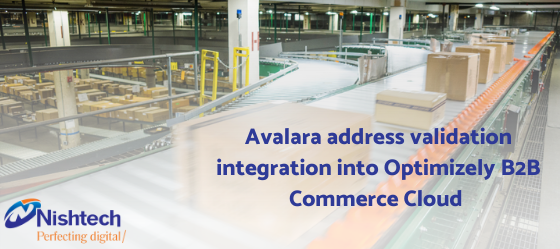Accelerating your B2B Commerce in the Optimizely Cloud
written by Himadri Chakrabarti
|June 2021
Optimizely Configured Commerce
Nishtech has built many ecommerce sites for our clients using Optimizely Configured Commerce, formerly known as InsiteCommerce. In fact, we've been doing this for over a decade. This platform has evolved from its infancy to a fully cloud-native API-first headless platform.
The purchase of InsiteCommerce in 2019 by Episerver (now Optimizely) introduced many new possibilities for the future direction of this platform. In this blog, I will go over the platform's key features and architecture. Hopefully, by the end of this, you'll understand why we like this platform so much and how it helps our clients with their businesses.
B2B Digital Commerce Platforms Market Leader
Optimizely Configured Commerce was created to help businesses with B2B commerce. The platform's foundation and features were designed with the assumption that it would be primarily used by B2B businesses. Optimizely Configured Commerce is widely regarded as the market leader in B2B Commerce.
The most recent IDC Marketspace Worldwide B2B Digital Commerce Platforms Vendor Assessment is provided below. Next to SAP, Optimizely Configured Commerce is one of the three market leaders.
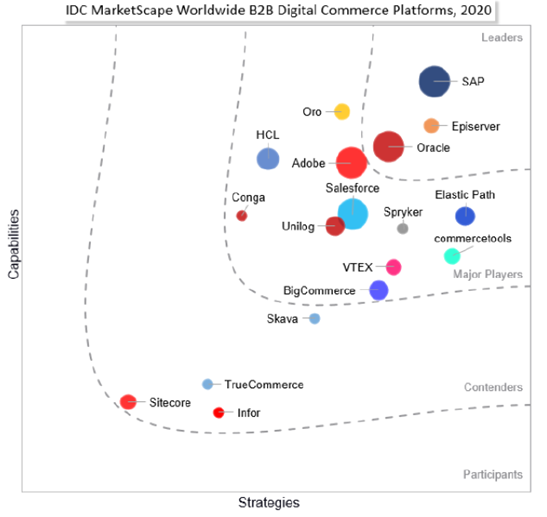
What's under the hood?
The Optimizely Configured Commerce platform was designed with the intention of selling products to businesses in mind. The concept of the customer (company or organization) purchasing products rather than the end-user is critical. Because the platform views the buyer as an organization, it has included features that an organization will require to manage the purchasing process. Some of these characteristics are discussed further below.
User Administration
The User Administration feature allows the organization to self-manage its users and their roles and responsibilities. The platform comes with a variety of user and buyer roles out of the box. A user with the Administrator role can add new users to the organization and structure their purchasing abilities by assigning them to buying accounts (bill-to and ship-to) for which they can purchase, as well as including them in different buyer roles to supervise their purchases.
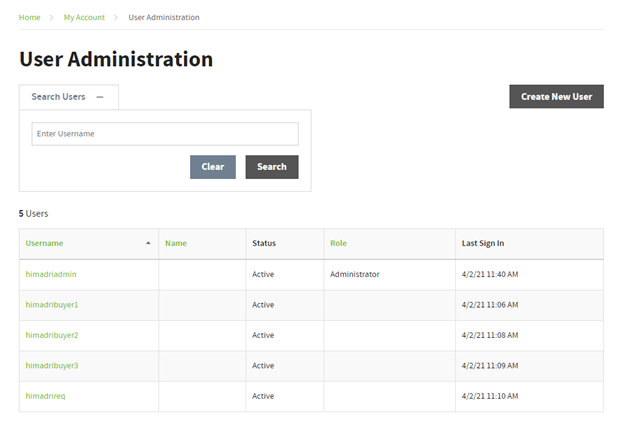
Order Approval
Optimizely Configured Commerce includes a comprehensive Order Approval workflow. The approval process is controlled by the user's role.
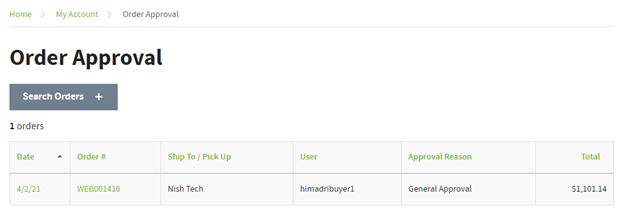
For example: a user in the Buyer3 role does not require approval; a user in the Buyer2 role requires approval to purchase after an amount has been assigned through Budget Management; and a user in the Buyer1 or Requisition role always requires approval to purchase from the site.
Approval workflow communicates between the requestor and approver via the site's Order Approval dashboard.
Budget Management
Organizations often need to manage their purchasing to keep expenses in control. If a company is purchasing stationery from a distributor, they will probably only want to spend money allocated in their budget for stationery.
Optimizely Configured Commerce Budget Management features, along with Order Approval Workflow, help companies create and maintain the budget for the designated period. All past budgets can be reviewed using the Budget Review feature.
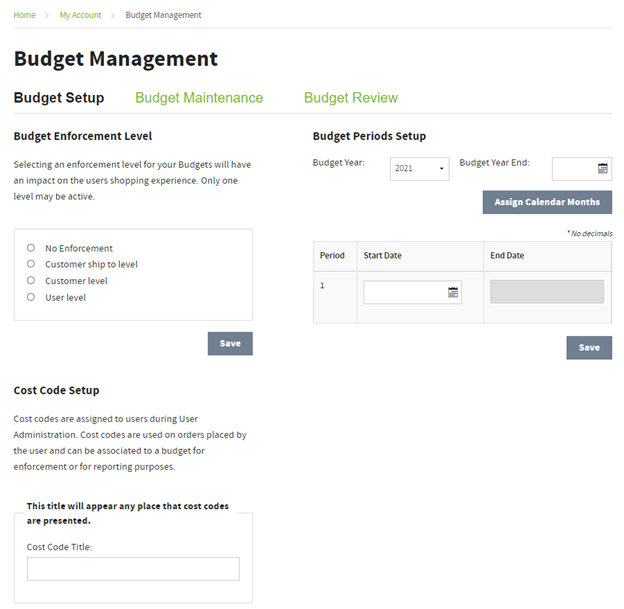
PunchOut
For bigger companies, budget management is not enough to control their spending. Often bigger companies will use a procurement system to manage their purchasing activities. Optimizely Configured Commerce's PunchOut feature integrates the company’s procurement system with the online store. PunchOut requires companies to sign up with PunchOut middleware service to complete the integration.
Request for Quote
Sometimes businesses can’t provide a price for certain products (this happens a lot for configurable products), or buyers want to negotiate the price for products. In these situations, the Request for Quote (RFQ) feature is very useful.
Optimizely Configured Commerce has a robust workflow for RFQ, where customers can request a quote for the items added to their cart. The quote request goes to the sales representative assigned to the customer, who can then review and modify the quote before sending it back to the customer.
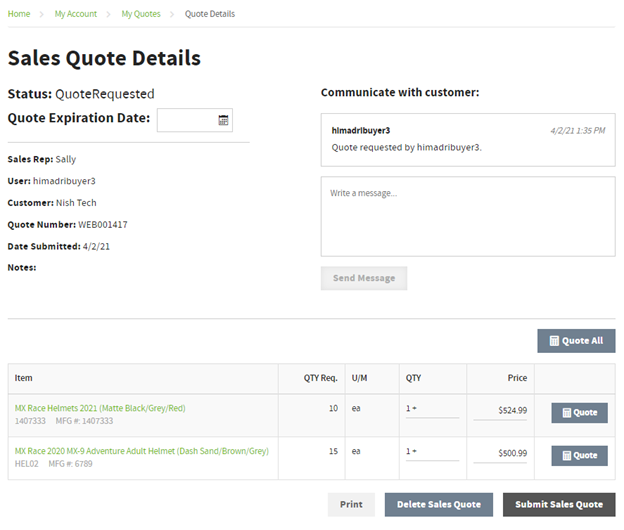
Customer-specific Products
The products sold by B2B businesses can be customized for their customers. One of our clients is in the packaging business. Often their packages are designed based on a customer’s specifications.
They do not want to show packages created for one customer to other customers because they cannot sell those packages to them. Optimizely Configured Commerce allows businesses to show and hide customer-specific products by creating restriction groups and configuring them using the powerful rules engine built in the platform.
Customer-specific Pricing
Price negotiation in B2B commerce is a common occurrence. Most businesses use complex contract pricing rules based on products, customers, and quantities.
Optimizely Configured Commerce supports contract pricing natively using a price matrix, and through real-time pricing by integrating with an ERP.
The price matrix approach requires loading, configuring, and maintaining pricing data in Optimizely Configured Commerce. Real-time pricing, on the other hand, connects to an ERP using an API interface and displays the price in the commerce storefront.
Optimizely provides built-in connectors to popular ERPs to enable real-time pricing. If an out-of-the-box connector doesn’t exist for an ERP, it’s easy enough to create an integration based on Optimizely's pricing service interface.
Ease of Purchase
Buying activities in B2B commerce are quite different than B2C. B2B customers usually come to the ecommerce store prepared with a list of items to buy. They will often buy in bulk and buy the same items repeatedly. Also, many times multiple users will participate in buying activities.
Optimizely Configured Commerce features are designed to optimize this pattern of buying activities. Customers can buy in bulk using the Quick Order form where they can quickly search and add items using auto-complete search and/or use a spreadsheet to upload items in the form.
Customers can use the Reorder feature in their past orders and place the whole or partial order again. The flexible features in Lists creation allow customers to create lists quickly from several places in the application. These lists can be shared with users in the organization and can be used for repeated buying.
Finally, the Reminder feature in the List can be used to remind themselves when some products should be purchased.
Tell Me About B2C
Optimizely Configured Commerce fully supports B2C purchasing workflows for authenticated and guest users. It allows businesses to connect the storefront with an ERP using a single customer account for B2C users. This way B2C user information (guest or authenticated) can be maintained in the commerce platform and not burden the ERP with numerous accounts.
One of the much-needed features for B2C commerce is the ability to create promotions easily and run promotional campaigns to drive sales. Optimizely Configured Commerce comes with strong product promotion capabilities driven by a powerful Rules Engine.
Credit card payments can also be managed on the Commerce platform. You can authorize, capture, void, or approve partial credit to the credit card from the Commerce Admin Console. And multi-site hosting capability allows businesses to manage B2B and B2C sites in the same commerce instance.
Integration Framework
One of the key features that distinguishes Optimizely B2B Commerce from other B2B commerce platforms on the market is its built-in Integration Framework. The ecommerce storefront serves as a front for customers to place orders, but much of the information presented to them is the result of integration with other backend systems such as ERP, PIM, tax service, shipping service, payment gateways, and others.
Optimizely has architected a foundational Integration Framework upon which integration with third-party systems can be built, but it also includes ready-to-use connectors for popular ERPs and PIMs. Because integration is a significant piece of work in any B2B commerce implementation, we discovered that this feature significantly reduces implementation costs and speeds up time to market.
Built-in Content Management System
Optimizely Configured Commerce includes Spire, a simple content management system (CMS) that has recently been re-architected. It also includes the older Classic CMS, which will be phased out in the future.
Spire is a React-based application that runs on Node.js and gives the business user more control over content management than traditional CMS. Spire is superior architecturally because it separates frontend and server-side code and can be scaled out as needed by adding more Node instances without affecting webserver scaling.
Having a CMS in the platform gives businesses a significant advantage because they can add and maintain additional pages and widgets in their own ecommerce store. It also significantly reduces implementation costs.
Architecture
Regardless of what platform is used to implement a B2B ecommerce website, there will always be a need to customize the platform to satisfy a customer’s requirements. The architecture of the platform will determine how much time and effort will be needed for customization. In economic terms, the client will spend more money to customize the platform if the architecture of the platform is poor.
Optimizely Configured Commerce's architecture was built with an Open-Closed Design Principle. This means that the architecture is closed for modifications, but it is open for extensions.
Closed for modifications separates the core platform code from custom code and protects the core platform code from any change. This makes the platform easy to upgrade to newer versions, which ensures new platform features/bug fixes are delivered quickly and cost-effectively.
Open for extensions allows the implementer to extend the platform quickly and easily. Optimizely achieved this principle by implementing several architectural constructs like pipelines, handlers, plugins, and services.
Optimizely Configured Commerce is also an API-first headless commerce platform. This means the UI stack (head) is completely separated from the commerce engine (body). The biggest benefit of a headless architecture is that outside platforms and services can integrate with Optimizely Configured Commerce easily via commerce APIs.
Below is the Optimizely Configured Commerce architecture stack.

Source: Optimizely
The Optimizely Configured Commerce offering is a cloud-native SaaS platform. In addition to removing all responsibilities of maintaining infrastructure, platform upgrades, code deployment and more, it also addresses application scaling as needed.
The time to go to market with a cloud-native implementation is much lower than when done on-premises. The cost of the subscription is based on the number of orders placed in a year and the number of SKUs available to purchase. So, the subscription cost is tied to the company’s revenue.
We think it is a fairer licensing model.
Platform Security
The Optimizely Configured Commerce platform security is based on OpenId Connect and OAuth2 protocol. This is the most secure industry-standard internet security protocol available today.
This open security protocol makes it possible to integrate outside services securely with Optimizely B2B Commerce. For bigger organizations where identity is managed using Single Sign-On, Optimizely Configured Commerce security can be seamlessly integrated with the organization's Identity Service.




